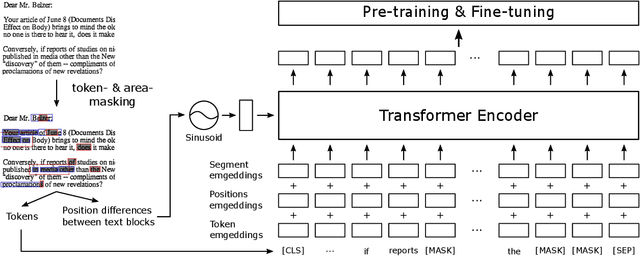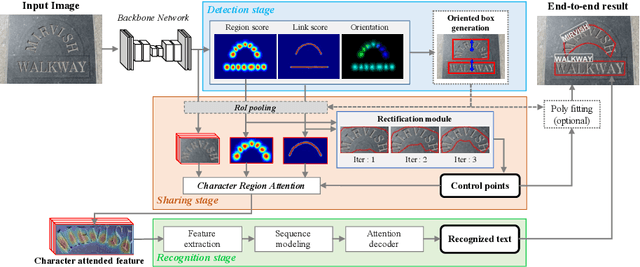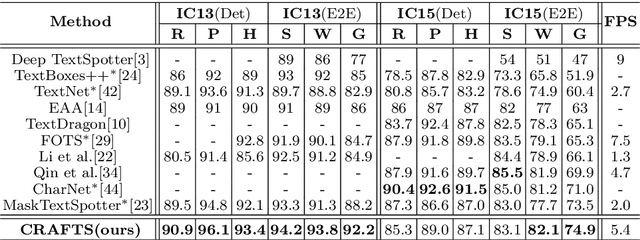Daehyun Nam
TRACE: Table Reconstruction Aligned to Corner and Edges
May 01, 2023Abstract:A table is an object that captures structured and informative content within a document, and recognizing a table in an image is challenging due to the complexity and variety of table layouts. Many previous works typically adopt a two-stage approach; (1) Table detection(TD) localizes the table region in an image and (2) Table Structure Recognition(TSR) identifies row- and column-wise adjacency relations between the cells. The use of a two-stage approach often entails the consequences of error propagation between the modules and raises training and inference inefficiency. In this work, we analyze the natural characteristics of a table, where a table is composed of cells and each cell is made up of borders consisting of edges. We propose a novel method to reconstruct the table in a bottom-up manner. Through a simple process, the proposed method separates cell boundaries from low-level features, such as corners and edges, and localizes table positions by combining the cells. A simple design makes the model easier to train and requires less computation than previous two-stage methods. We achieve state-of-the-art performance on the ICDAR2013 table competition benchmark and Wired Table in the Wild(WTW) dataset.
BROS: A Pre-trained Language Model Focusing on Text and Layout for Better Key Information Extraction from Documents
Sep 10, 2021



Abstract:Key information extraction (KIE) from document images requires understanding the contextual and spatial semantics of texts in two-dimensional (2D) space. Many recent studies try to solve the task by developing pre-training language models focusing on combining visual features from document images with texts and their layout. On the other hand, this paper tackles the problem by going back to the basic: effective combination of text and layout. Specifically, we propose a pre-trained language model, named BROS (BERT Relying On Spatiality), that encodes relative positions of texts in 2D space and learns from unlabeled documents with area-masking strategy. With this optimized training scheme for understanding texts in 2D space, BROS shows comparable or better performance compared to previous methods on four KIE benchmarks (FUNSD, SROIE*, CORD, and SciTSR) without relying on visual features. This paper also reveals two real-world challenges in KIE tasks--(1) minimizing the error from incorrect text ordering and (2) efficient learning from fewer downstream examples--and demonstrates the superiority of BROS over previous methods. Our code will be open to the public.
Character Region Attention For Text Spotting
Jul 19, 2020



Abstract:A scene text spotter is composed of text detection and recognition modules. Many studies have been conducted to unify these modules into an end-to-end trainable model to achieve better performance. A typical architecture places detection and recognition modules into separate branches, and a RoI pooling is commonly used to let the branches share a visual feature. However, there still exists a chance of establishing a more complimentary connection between the modules when adopting recognizer that uses attention-based decoder and detector that represents spatial information of the character regions. This is possible since the two modules share a common sub-task which is to find the location of the character regions. Based on the insight, we construct a tightly coupled single pipeline model. This architecture is formed by utilizing detection outputs in the recognizer and propagating the recognition loss through the detection stage. The use of character score map helps the recognizer attend better to the character center points, and the recognition loss propagation to the detector module enhances the localization of the character regions. Also, a strengthened sharing stage allows feature rectification and boundary localization of arbitrary-shaped text regions. Extensive experiments demonstrate state-of-the-art performance in publicly available straight and curved benchmark dataset.
CLEval: Character-Level Evaluation for Text Detection and Recognition Tasks
Jun 11, 2020



Abstract:Despite the recent success of text detection and recognition methods, existing evaluation metrics fail to provide a fair and reliable comparison among those methods. In addition, there exists no end-to-end evaluation metric that takes characteristics of OCR tasks into account. Previous end-to-end metric contains cascaded errors from the binary scoring process applied in both detection and recognition tasks. Ignoring partially correct results raises a gap between quantitative and qualitative analysis, and prevents fine-grained assessment. Based on the fact that character is a key element of text, we hereby propose a Character-Level Evaluation metric (CLEval). In CLEval, the \textit{instance matching} process handles split and merge detection cases, and the \textit{scoring process} conducts character-level evaluation. By aggregating character-level scores, the CLEval metric provides a fine-grained evaluation of end-to-end results composed of the detection and recognition as well as individual evaluations for each module from the end-performance perspective. We believe that our metrics can play a key role in developing and analyzing state-of-the-art text detection and recognition methods. The evaluation code is publicly available at https://github.com/clovaai/CLEval.
 Add to Chrome
Add to Chrome Add to Firefox
Add to Firefox Add to Edge
Add to Edge